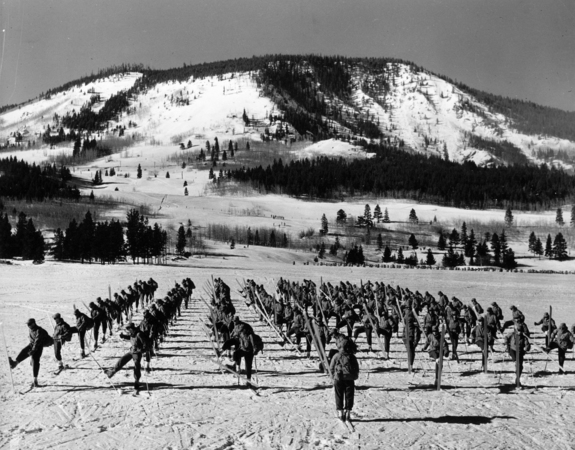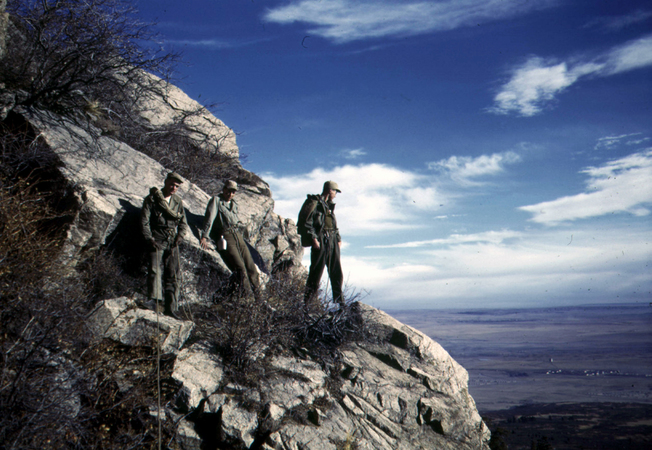This past October, Colorado’s Camp Hale was designated as a national monument. The training ground of the United States’ first mountain warfare unit, Camp Hale’s designation as a national monument protects the famed 10th Mountain Division’s historic home and the 50,000+ acres of untouched wilderness in the Tenmile Range around it. While the mountain west and Camp Hale are most often associated with the 10th Mountain Division, its roots are in the Northeast and its members have significantly impacted outdoor recreation in the region.

Charles Minot “Minnie” Dole
The driving force behind the creation of the 10th Mountain Division was Charles Minot “Minnie” Dole. Born in Tyngsborough, Massachusetts, and an eventual resident of Greenwich, Connecticut, Dole was an avid outdoorsman and a member of the prestigious New York Amateur Ski Club, a group whose annual visits to Stowe in the early 1930s helped kickstart the region’s fledgling ski areas.
As Dole began pushing for the creation of a division of American troops specifically trained to fight in the mountains, he was coming off another significant (and quite relevant) accomplishment: the founding of the U.S. National Ski Patrol (NSP). In 1938, he’d experienced the need for an organization dedicated to organized mountain rescue firsthand after he’d broken his ankle while skiing in Stowe.
Shortly after getting the NSP off the ground, and as countries around the world spiraled into unimaginable conflict, Dole determined that the United States had a much more urgent need—repelling a German attack on the country from Canada. Dole accordingly began lobbying for the creation of a defensive mountain warfare unit modeled after the Finnish ski troops that had provided strong resistance to an invasion from a much larger and better-equipped Russian army in 1939 and 1940. Despite being outnumbered by 200,000 to 1,000,000 and lacking the mechanization of the armor of the Russians, the Finns exacted a significant number of casualties and kept the invading forces at bay using guerilla tactics, their knowledge of skiing, and cold-weather skills.

The Founding of the 10th Mountain Division
Even in the then-isolationist United States, Dole’s lobbying quickly made an impression, with the Army asking Dole and the NSP to help recruit candidates and recommend equipment and training. Although this was the first time that the Army had looked to a civilian organization for recruiting assistance, the Army was perhaps just following Dole’s admonition that “it is more reasonable to make soldiers out of skiers than skiers out of soldiers.”
Charles McLane was one skier who sought to prove Dole correct. One of the first volunteers for what would become the 10th Mountain Division, the Manchester, New Hampshire, resident and former captain of the Dartmouth ski team crossed the country to the mountain unit’s first base—Fort Lewis in Washington—to enlist in person. Well-educated and already possessing backcountry survival skills, McLane is an excellent archetype of the kind of person attracted to serve in the force.
Many others in the unit’s early days fit this bill, too. Two-thirds of the eventual 10th Mountain Division’s soldiers would qualify as officers, and recruits included a former assistant to Albert Einstein, Olympic medalists, and accomplished mountaineers. Many had roots in the Northeast; Vermonters alone accounted for 260 men among the original 10th Mountain Division.
Martin “Marty” Daneman summed this all up when he described his enlistment into the 10th Mountain Division in 1943: “I’ll be intellectual when I get out and start to live a normal happy life with you…There is every type of person—authors galore…There are quite a few German refugees, also, well-educated people. The rest are mostly from New England and N.Y.”
The 10th Mountain Division’s Early Homes
Before Camp Hale was constructed, the 10th Mountain Division was stationed at Fort Lewis and spent a significant amount of time training on the neighboring Mount Rainier. Early in that training, the Division sought to demonstrate its mountaineering bona fides, attempting a ski ascent of Rainier, the fifth-highest mountain in the continental U.S. The trip was led by Corporal Peter Gabriel—a famous Swiss mountaineer and formerly of New Hampshire’s Franconia Ski School—and successfully summited the peak, although the unit substituted skis for crampons on the icy upper slopes of the mountain.
Camp Hale was ultimately established in 1943 and the troops arrived at the cold, windy garrison situated at over 9,000 feet soon after. Conditions at Camp Hale were tough, the training intense, and recreational opportunities scant—earning the camp the nickname “Camp Hell.” It also left the troops exceptionally well prepared for the harsh conditions required of a mountain unit.

The 10th Mountain Division, World War II, and the Aftermath
Although Dole had envisioned his mountain warriors as a defensive force, as the United States’ involvement in World War II deepened, the Division’s role changed. Some members of the Division participated in the 1943 campaign to liberate Alaska’s Aleutian Islands from Japanese occupation. Then, in late 1944, the Division crossed the Atlantic to Europe, where it played a prominent role in the battle of Riva Ridge in Italy, employing its mountain warfare skills, including rock climbing, to defeat the Germans.
With World War II ending soon after, the 10th Mountain Division was temporarily deactivated in 1945. However, the contributions of the unit’s original members continued long after their service.
One of the places where the 10th Mountain Division has had the most lasting influence is skiing. 10th Mountain Division veterans founded, developed, or managed more than 60 resorts. In New England, Jack Murphy, an instructor to the 10th Mountain Division, co-founded and served as General Manager at Sugarbush. Sixteen veterans of the 10th have worked at Stowe Mountain Resort while other alumni ran or worked at mountains such as Waterville Valley, Bromley, Mount Ascutney, Cranmore, Attitash, and Black Mountain. Mount Wachusett, in Princeton, Macssuchetts, also honors the soldiers of the 10th Mountain Division; a plaque has graced a rock near the summit since 1975 and one of the ski trails from the top is aptly named 10th Mountain Trail.
The 10th Mountain Division Today
In 1985, a new 10th Mountain Division was organized at Camp Drum, New York—returning the famed unit back to its Northeast roots. Today, its members are among the soldiers who train at the Mountain Warfare School at the Camp Ethan Allen Training Site in Jericho, Vermont. Smugglers Notch serves as a location to drill climbing, skiing, and avalanche safety skills.
On top of the Northeast’s most famous peak—Mount Washington—sits a plaque commemorating the 10th Mountain Division’s members from the Northeast who lost their lives during World War II. The plaque reads, in part: “Dedicated by the New England Chapter of the 10th Mountain Division in memory of comrades who gave their lives in the Aleutians and Italy in WW II.”
Tim Peck and Doug Martland
Tim and Doug met long ago at the Eastern Mountain Sports in Canton, Massachusetts. Bonding over a love of slick Quincy Quarry granite, White Mountain sufferfests, and scheming up adventures while folding tee-shirts, today Tim and Doug collaborate to write about their favorite outdoor activities and occasionally get nostalgic about tee-shirt tables.
Related Posts
April 2, 2024
10 Tips for Mountain Biking Etiquette During Mud Season
One rough spring could ruin the…




